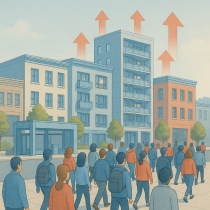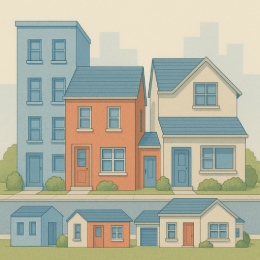The Changing Housing Landscape in Canada
To understand the changes in Canada’s housing market, you have to look at residential real estate as an industry. And just like any other industry, its dynamics come down to the prevailing political, economic, social, technological, legal, and environmental factors. So, which of these influences has had the biggest effect and why?
Social Dynamics
A housing market comes down to the people it serves. And a close look at Canada’s housing market reveals the following changes:
Population Growth

In the past few years, Canada has embarked on several immigration programs that have been designed to increase the country’s population to account for the evident population gap. Luckily, these programs have been successful, and many immigrants have moved to Canada in search of education and employment opportunities. While this has boosted the local economy by providing skilled and unskilled labor, it has created a housing supply shortage.
Why is this the case? Well, it comes down to the mismatch between new builds and the increasing population. As much as more developers have invested in new construction, the number of new homes has not kept up with the growing number of people. And with this mismatch, home prices have gone up, thus spurring an affordability challenge for aspiring renters and homeowners.
Household Structure Changes

Canada’s housing market has seen two contrasting household structure changes over the years, both of which have been driven by different pain points. In the first instance, the size of households has been reducing. Not only are people choosing to stay single for longer, but also many young families are delaying having kids until much later. For some, this decision comes down to money, while for others, it is a matter of priorities or preferences. At the same time, people are living much longer, and many older adults are downsizing to smaller homes. All these people need small units, which has resulted in the increased demand for small homes, such as studios and one-bedroom apartments.
The second instance relates to the housing supply issue covered in the previous point. With a limited housing supply, house prices have gone up, and many young adults have chosen to live with their parents to save money. This trend has grown so much that multi-generational living, as was the case in the past, has become the norm again. For this reason, many families are opting for homes with additional space to accommodate their adult children with separate suites within the larger homes.
A Note on Rural Communities
It also helps to note that the Arctic regions of Canada are facing similar housing problems. To start with, the indigenous population is one of the fastest-growing in Canada. But with the limited housing supply, which mainly comprises single-family homes and lacks a thriving rental market, overcrowding is quite common in these communities. What’s more, since many of their homes were built before 1980 and are in dire need of repair and maintenance, many of them have issues such as black mold, limited or lack of utilities, and structural defects. With all these housing issues, these rural areas have a hard time attracting and retaining essential workers, which has a negative effect on the community’s well-being.
Environmental Aspects
Housing markets all over the world have been changing as more developers adopt more environmentally-friendly solutions. Is this the case with Canada? Why, yes! Developers have especially invested in new builds that offer the following perks:
Higher Energy Efficiency
As Canada works on achieving net-zero emissions, developers have been compelled to play their part in reducing the nationwide energy consumption. They are now using various designs to achieve this, ranging from high-efficiency heating to enhanced insulation techniques, all of which enable homeowners to cut down on their utility bills.
Climate Resilience
With climate change rearing its head, developers have come to realize that they must put up homes that can withstand its negative effects. Over time, features such as waterproofing, flood protection, and space cooling have become commonplace. More homeowners and renters are also seeking spaces with these additional features, which has pushed more developers to design resilient homes.
The Use of Sustainable Materials
Construction is known to have a high carbon footprint, and developers have been tasked to find ways to reduce this. One effective approach has been the use of renewable and recycled construction materials, such as mass timber, in their builds.
More homeowners and renters are becoming more environmentally conscious, and a good number of them are willing to pay higher home prices or rents if it helps them preserve the environment. It is thus not surprising that newer constructions seem to have a sustainability focus.
Technological Upgrades
All across Canada, different industries are relying on technology to simplify their operations while maximizing their profits. And as it turns out, the housing market has followed suit in the following ways:

Modern Construction Methods
New construction takes time owing to the several stages required, as well as interruptions due to severe weather. Luckily, developers can now rely on innovative technologies such as modular and factory-built housing to speed up the construction process while ensuring that the final builds are of high quality. Already, many developers have adopted these techniques, and the government is hard at work promoting these methods.
Digital Planning Tools
Construction projects comprise several stages and often have several moving parts that require collaboration between different areas of expertise. As such, a simple delay from one person can result in the project stalling. What’s more, one error can result in time and money losses. By incorporating digital planning tools, developers can reduce these chances of errors and delays by ensuring that people working on the project can communicate in real-time. Many of these tools also include design options that can help builders make tweaks on the go while sharing the new designs with their colleagues.
The whole idea behind embracing technology in housing is to reduce the cost of construction while increasing the speed and efficiency of operations, all of which can help combat the limited housing supply.
Legal Influences
At the end of the day, the government plays a big role in the housing market. After all, it makes the policies that determine the permits that developers must have, how much construction workers get paid, the cost of construction materials, and much more. So influential is the government that a policy can make or break the housing market. But which way are they leaning?

Strict Zoning Regulations
As things stand, many developers are calling on their local governments to embark on zoning reforms. But why is this? The problem stems from the restrictive zoning regulations at the local level, many of which will only permit single detached homes near transit zones and infrastructure. As such, even though more people are demanding single units, acquiring permits to develop such houses is proving hard for developers.
Slow Approval Processes
Before developers can break ground, they have to go through a series of checks, after which they can acquire the necessary permits to put up new houses. Unfortunately, in many housing markets in the country, the municipal offices are quite slow with these approvals due to bureaucracy. Developers often have to deal with significant delays that rack up their construction periods and costs, which they pass on to new tenants and homeowners, worsening the affordability problem.
High Municipal Fees
Developers are pushing back on local governments for the fees charged for construction. Not only are developers subject to development charges, but they are also expected to pay levies as well as other fees. Often, developers add these costs to the final sale or rent prices of the homes. But with more homeowners and renters citing high prices as their reasons for not investing in the housing market, some developers are scaling back on their operations to avoid incurring losses.
It is safe to say that the current development fees, coupled with the slow processes at the municipal levels, are compounding the housing supply issue. The same problem arises when we look at the Arctic regions of Canada. On-reserve homes are on communal land, and the law prevents homeowners from using these homes as collateral for private mortgages. As such, aspiring homeowners cannot access conventional financing for these homes, which has negative effects on the private housing market in these areas.
Economic Pursuits
If you were to look at housing a few decades back, you would see that Canadians viewed housing as a basic need. In fact, it was on the same level as clothing and food. It was a necessity. But this perspective has now changed for a good number of investors in the housing market, which has shaped housing supply and demand. How?
Housing as an Investment
Many people have come to learn that real estate in Canada is a lucrative investment, what with the capital appreciation and long-term returns. What’s more, investing in housing has become much easier, thanks to investment vehicles like real estate investment trusts as well as the ease of securing home financing. Put together, these investment avenues have enabled more people to secure housing as investments, which has resulted in the increased demand for housing, more so when it comes to properties that can fetch premium rents. While this has benefited developers who have been able to increase their profits, it has had some adverse effects, such as the gentrification of neighborhoods and the displacement of low-income residents.
The Perks of Home Ownership
The housing market in Canada has often favored homeownership, as homeowners receive both direct and indirect subsidies, including tax benefits. This privilege has had different effects on the housing market. On the part of the developers, the focus has been on putting up new builds with homebuyers in mind. And on the part of the residents, the easier choice has been to own a home in order to benefit financially in the future. But there is a downside to this. With developers focused on putting up homes for sale, they have not put up enough rental houses. If anything, rental housing has become a residual market.
The imbalance brought on by the privilege of home ownership is growing bigger now that more people are looking at homes as an income source. On the plus side, many of these new homeowners are putting up their investment homes for rent. But on the flipside, they are charging premium rents for these properties, seeing as they acquired them at a high price because of the high demand.
